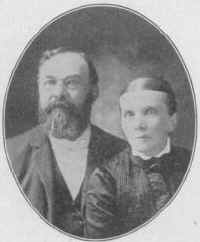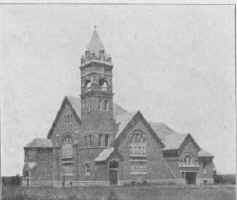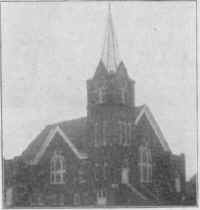bent forward, and allowed her boys one by one to climb on her back, and from it
to raise themselves through the opening in the low ceiling to the attic, and
retire for the night.
One more instance in which the writer himself had a part. It was in the
memorable winter of 1880-1881, when the first real blizzard of the season came
on the 15th day of October, and after that storm and severe cold weather, and an
abundance of snow remained until the middle of April. It was our first winter in
these parts, and while we had brought all our furniture from Michigan and the
house that had been erected as a manse was one of the best then to be found in
the whole county; and while we had stoves to heat that home, and the
parishioners had bountifully supplied us with all that we could wish for the
table, we could not have suffered very much, if only coal could have been
obtained. But that was out of the question, sometimes for weeks in succession,
because of the distance to the nearest railroad station, and especially because
even these distant trains were handicapped by the snowdrifts, and unable to
bring the coal. We had managed to feel contented and happy, notwithstanding the
great sacrifice of home comforts we had made, as well as of the splendid school
privileges for the children we had left behind. But for one week a feeling of
dissatisfaction, and of longing for the fleshpots of Egypt took possession of
our heart, and we took pity on ourselves. It so happened that the writer with
his family, and one of the elders and his lady were invited to spend the day
with one of our parishioners, a large family, with but very limited means. Upon
arriving there, we found but three chairs in the house, not enough even to
accommodate the adults of the invited guests; but contentment and happiness
shone from the faces, and were echoed in every word that our entertainers spoke
the whole day. It was then and there that the writer became ashamed and penitent
for his feeling of dissatisfaction, and resolved that, if these people could be
so grateful and full of happiness and true joy under such circumstances, I
indeed had no reason whatever to complain, but only cause for gratitude and full
resignation.
Undoubtedly many more items could be added to those here selected, but I have
already occupied more space than ought to have been taken, and will therefore
come to a close here, knowing that these will at least give some idea of what
the early settlers at Sioux Center have had to contend with.
WEST BRANCH TOWNSHIP AND THE TOWN OF
SIOUX CENTER.
BY REV. JAMES DE PREE.
West Branch township, which presumably derives its name from the fact that
the West branch of the Floyd river flows through it from about the Northeast
corner to the Southwest, cutting it into nearly two triangles, is bounded as
follows: on the North by Welcome, on the East by Holland, on the South by
Sherman, and on the West by Center township. The above named stream provides an
abundant water supply, and as the land gently slopes and undulates towards the
river from both sides, it also provides ample drainage, so that nearly every
acre of its 36 sections is very valuable for agricultural purposes.
Less than half a century ago it was the roaming place and home of the
buffalo, elk, prairie wolf, etc., while now hardly one square foot of unbroken
prairie can be found within its borders. Its entire space has been turned into
beautiful and most productive farms, with luxurious homes, extensive and
commodious barns and stables, well filled granaries protected and nestled behind
artificial grove.

REV. MR. AND MRS. JAMES DE PREE.
Thousands of cattle are grazing in the meadows, and annually tens of
thousands of fat porkers are shipped from its borders to the world's markets;
all this tells the tale of abundance and wealth the township affords, and of the
industry and thrift of its inhabitants.
Soon after the Hollanders came to Sioux County in 1870, this township was also
taken possession of, and after but a few years it had been almost entirely
"taken by the Dutch." According to the records the first ones to take
a claim were John and Henry Hospers, who both received a patent on the same
date, Dec. 1st, 1871. Somewhat more than two years later the first patent west
of the West Branch river was obtained by Jacob Westra, the northwest 1/4 of
section 4. This very parcel was, fifteen years later, sold to the Great Northern
Land Co. and with the tract just opposite in section 5, bought by the same
company from Mrs. De Mots, became the sight for the now thriving and steadily
growing village of Sioux Center. This is the only town in the township, and, as
its name indicates, is located very near the geographical center of Sioux
County.
In the spring of 1881 the writer himself assisted the survey, or in laying out
the north half of the northwest % of the northwest 1/4 of section 9, twenty
acres owned by the First Reformed Church organization, into four blocks of five
lots each. The plat was filed for record May 30th, 1881. Upon the northwest
block of the plat, the First Reformed Church still has its beautiful church
edifice and commodious parsonage. This became the nucleus for a little town,
some business enterprises were started here, and for a time it seemed that its
location was established. But when, in 1890, the Great Northern Railroad Co.
platted its property about three-quarters of a mile north from this plat, into
village blocks and lots, and built its road, and located its depot there, all
the business was soon removed to that site. When, however, later on the village
was incorporated, what is generally called "the old town," was
included in the corporation
and the name Sioux Center retained for the whole; and now one continuous line of
homes on three adjoining streets has already connected the two sites and formed
them into one.

THE FIRST REFORMED CHURCH, SIOUX CENTER.
The population of the town is rapidly approaching the 1,000 mark. It has three
good sized churches, all of brick; two school houses, one bank, one good hotel,
and several fine brick business blocks, two lumber yards and two elevators. To
give some idea of the prosperity of the place, and the surrounding community, as
also of the religious status of the same, we may state that within the last five
years as much as $50,000 has been collected or pledged for the erection of the
three handsome church structures that have been reared in that time; all this
was done without any aid from outside.
SOME OF THE EARLY HOMESTEADERS.--Among some of the homesteaders who took
claims in West Branch Township, and who are still living in and around Sioux
Center, or who remained there until their departure from this life, may be given
the following names: T. Wayenberg, H. Mouw, H. J. Wissink, G. H. Rensink, H. W.
Rensink, G. Van Beek, P. Schut, D. J. Wesselink, D. W. Doornink, Aart Fronken,
J. Franken, J. Ver Meer, E. Den Herder, J. Van den Berg, J. Van Grevenhof, Et
Mouw, Gerben De Vries-Sec. 20; Sander Schut-Sec. 2; H. W. Beernink-Sec. 8; John
Pekeler--Sec. 8; G. Zeutenhorst--Sec. 6; Gysbert De Zeeuw -Sec. 26; G. W.
Wesselink-Sec. 10; B. W. Jansen--Sec. 10; Gerrit Niekamp--Sec. 18; G. Kempers--Sec.
3; E. Van de Brake--Sec. 20; J. W. Te Grotenhuis-See. 6; J. R. Van der Schaaf--Sec.
26; Hein Kosters--Sec. 8; Hendrikus Kosters--Sec. 8; Frederick Kuhl--Sec. 10;
Jacob Dolman, G. Van de Brake-Sec. 20; J. D. Wandscheer and Fred Franke--Sec.
30. Some of these have already retired from the farm, while some of them are no
longer in the land of the living. They bravely bore the brunt of the struggle
and privations which are always incident upon pioneer life; courageously and
hopefully continued to till these fertile fields, even when for several
successive years, their efforts were thwarted by the grasshopper scourge, which
devastated thousands upon thousands of richly promising acres of grain. To their
industry and perseverance, confidently relying upon God's kind providence in
leading them to these regions, and above all, to the Lord's goodness and mercy,
who granted unto them this measure of perseverence and industry, and heard their
prayers, and in His own good time bestowed upon them His richest blessings, is
due the fact that these once bleak prairies have been converted into a veritable
garden spot, and from the abode and haunts of wild animals into the heritage of
thrifty and prosperous tillers of the soil.
This sketch could hardly be considered complete unless mention was also made of
the religious, or ecclesiastical advantages that were sought and obtained. While
it is certain that the object of all who settled here was to improve their
temporal condition, we may be assured, however, that they by no means intended
to sacrifice their own, or their offsprings' spiritual welfare. The fact that in
all the different localities and towns that have sprung up in this colony,
churches were organized and commodious church edifices were built is evidence of
the deeply religious tendencies of the people, and this is equally true of those
that took possession of West Branch Township and of those who inhabited the town
of Sioux Center. For three or four years their church home was at Orange City,
and they were very regular in their attendance upon the Sabbath services there,
though most of them lacked facilities to ride, and had, therefore, to walk eight
or ten, or even twelve miles, and then we do not speak yet of the absence of
bridges in these primitive days, and of the necessity of wading through sloughs
and even the West Branch River. In order, also, to meet the spiritual needs of
all, the pastor of the Orange City Church, the venerable Rev. S. Bolks, with his
characteristic zeal and strong desire for the spiritual interests of all the
colonists, came every other week, on some week day, and preached in school
houses in two or three different localities. The Lord was pleased to greatly
bless these ministrations and even now these. early settlers can never forget
the pastoral love. and care that was bestowed upon them by this servant of God.
In May, 1877, the first church organization was established under the care of
the Reformed Church in America, with twenty-five charter members, and soon a
small building was erected upon almost the same site where the present First
Reformed Church edifice stands, and from that time regular Sabbath services were
held there. In March, 1880, a call was extended to Rev. J. De Pree, and in July
he began his labors as pastor here, the church at that time consisting of
thirty-one families and sixty members. He still continues to be the pastor of
this church, having for more than a quarter of a century enjoyed the good will
of the people, and the favor of Him who sent him there. About two years ago the
church commemorated the twenty-fifth anniversary of his pastorate here with
appropriate festivities.
For several years the church enjoyed a phenomenal increase, as the country was
rapidly taken in. In 1884 a large new church was built, a frame building, which
after but a few years, could hardly accommodate the ever increasing numbers that
were gathered in. A gallery was then built, which increased the seating capacity
to seven hundred, but that too was soon filled. In the year 1895, however,
several families living from five to ten miles northwest of Sioux Center were
organized into a church at what subsequently was named Carmel, this giving more
room again, and the following year when the Christian Reformed organization
received a regular pastor, another drain occurred, several families wishing to
be transferred to it. Then again in 1900 a number of the church families were
transferred to what became the Second Reformed Church of Sioux Center. Since
then it has never been necessary to say, "the place where we dwell with
Thee is too strait for us." Yet the church has always held its own, and
still ranks second among the churches of the classis of Iowa.
The great calamity of the church came in June, 1902, when the church building
was blown down by a hurricane, completely destroying its sixteen-hundred dollar
pipe organ, and two of the four stables, and half of another which were built
for sheltering the teams during the hours of service on the Sabbath. For just
about one year the people were without any church home and deprived of many of
the regular privileges of church life, although they were fraternally permitted
to make use of the Christian Reformed Church for some of the Sabbath services.
But even that calamity seemed but a blessing in disguise, as just one year later
they were enabled to dedicate to the Lord's service a very substantial,
commodious brick edifice, which in strength and beauty and convenience, far
surpassed the one that was destroyed and exceeds any other house of worship in
the county at the present time.
THE CHRISTIAN REFORMED CHURCH, SIOUX CENTER.
REV. WM. P. VAN WYK.
The church is a daughter of the Christian Reformed Church at Orange City. It was
organized A. D. 1890, then numbering only seven families. During the first
period of its existence the church encountered many hardships and struggles.
From 1892 until 1894 the Rev. Henry Bode Home, missionary, was stationed at
Sioux Center, and labored conscientiously for the good of the church. The Rev.
Henry Beets was the first pastor of the church and during his abiding among the
people from 1895 until 1899 the congregation increased to such an extent that a
larger edifice was necessary to accommodate the people. This second building was
erected in 1896.

THE CHRISTIAN REFORMED CHURCH, SIOUX CENTER.
The church still grew during the pastorate of Rev. John Smitter, who stayed four and one-half years as its pastor. In the fall of 1904,
Rev. S. P. Van Wyk assumed the ministry of the church. Feb. 11, 1906, the church
building burned down and the same year the present structure was erected at the
cost of seventeen thousand dollars. The congregation is in a flourishing
condition and numbers one hundred and forty families.
Continued
on Page 6
|